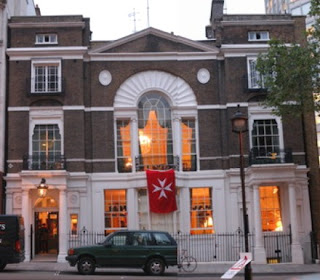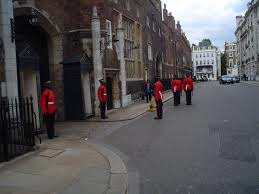
During the Regency and Victorian eras, Boodle’s Club, in St. James’s Street, was noted for the number of baronets who were members. It’s been recorded that when a waiter called out “Sir John, you are wanted,” a whole host of gentlemen would at once respond. This is rather a quaint anecdote, but it must be remembered that the club was established chiefly for “county people,” who had a proper respect for their own importance. Until the late 19th century, before Boodle’s came under the management of a committee, there was a kind of secret tribunal, the members of which were fictitiously supposed to be unknown. “This conclave conducted its proceedings with great secrecy, and its very existence was only inferred from the fact that at intervals, varying from six months to fifteen years, some printed notices appeared in the club rooms.” But these notices only referred to dogs or strangers, who were looked upon by the ancient members as very objectionable intruders.
Another rule was that members dining in the coffee room must wear evening dress. However, there was another apartment for those who found it necessary to keep to their morning clothes. Boodle’s was very strict and chaste on etiquette laws. Boodle’s Club was originally known as the “Savoir Vivre,” and took its particular name from the founder, and was established, like many of the other famous clubs of the day, in St. James’s Street.Gaiety and the joy of good living marked its early career very conspicuously, as may be gathered from “the Heroic Epistle to Sir William Chambers,” I773:
For what is Nature ? Ring her changes round,
Her three flat notes are water, plants, and ground ;
Prolong the peal, yet, spite of all your clatter,
The tedious chime is still ground, plants and water ;
So, when some John his dull invention racks,
To rival Boodle’s dinners or Almack’s,
Three uncouth legs of mutton shock our eyes,
Three roasted geese, three buttered apple pies.
White’s, Brookes’s, and Boodle’s for many years fought for supremacy, with masquerades, dinners, and “ridottos.” Boodle’s outside appearance is still very unpretentious, and perhaps sombre, from an architectural point of view, but the interior has a number of interesting features, especially in regard to some of the pictures by Gillray and others.
Among the exceedingly eccentric members of the club, two at least are deserving of passing comment. Michael Angelo Taylor, at one time M.P., and John, the tenth Earl of Westmorland. Taylor was “Paul Pry ” personified, and was an everlasting gossip. The Earl was very thin. Coming in one day, says Edward Walford in “Old and New London,” Taylor found Lord Westmorland, who had just dined off a roast fowl and a leg of mutton. “Well, my lord,” said Taylor, “I can’t make out where you have stowed away your dinner, for I can see no trace of your ever having dined in your bare body.” “Upon my word, I have finished both, and could now go in for another helping,” replied Westmorland. Walford adds that his lordship was notorious for his prodigious appetite, and on several occasions was known to have eaten the better part of a good joint and a couple of fowls.

The Club house, at No. 28 St. James’s Street, was designed by the Adams brothers and erected by John Crunden about 1765. The saloon on the first floor at Boodle’s is still noted for the stateliness of its appearance, opening from which on each side are two small apartments. One of these, according to tradition, was, in the Regency days of high play, managed by a cashier who issued counters and occupied himself with the details connected with the game; while the other room was reserved for special gambling members who wished to play in quietude.
It was not an easy matter to be elected a member of Boodle’s, and when Mr. Gayner became the manager, he would sit in state in a small chamber adjacent to the principal saloon, or front room, which, of course, was sacred to the members. Says Ralph Nevill, “When a candidate was proposed they (the members) walked across and deposited their black or white balls, after which they retired again to the front room. After a short time Mr. Gayner would shout ‘elected’ or ‘not elected,’ as the case might be, the ceremonial being gone through separately for every candidate.” But Mr. Gayner, it is said, took no account of the balls, but scrutinized all who were proposed from his peep-hole, and if they did not meet with his approval the black ball predominated.
Mr. Gayner, notwithstanding, was a very liberal and kind man, and prevented many a young fellow from getting into the hands of the money lenders and usurers who were in constant wait for the young unfledged geese who were ready to be plucked, by advancing them the wherewithal to assist them out of impending difficulties. There are several anecdotes in regard to his generosity and kindness in such cases. He always kept a large amount of cash in his safe, and at his death is said to have been owed no less than £10,000, which, however, by a clause in his will, was not to be demanded from the borrowers. After his death, Mr. Gaynor’s sister succeeded him in the proprietorship of Boodle’s. She died in 1896, when the club was purchased by its members.















